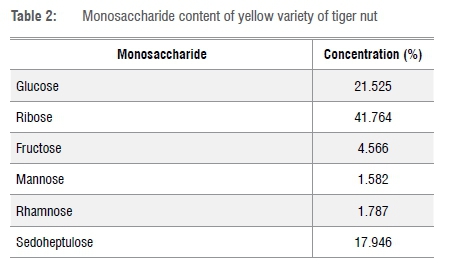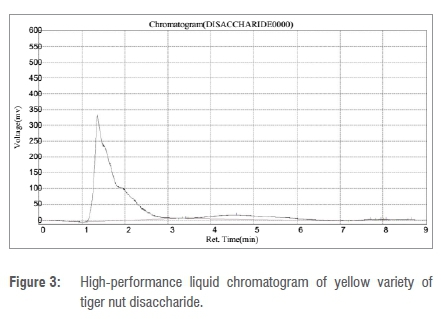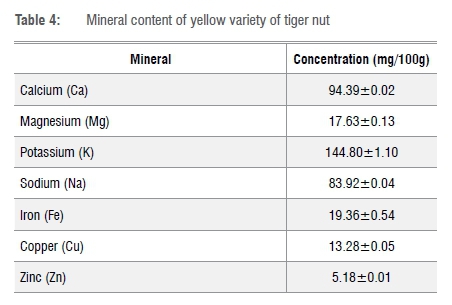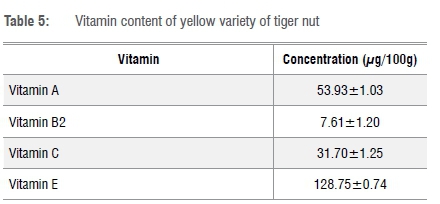Services on Demand
Article
Indicators
Related links
-
 Cited by Google
Cited by Google -
 Similars in Google
Similars in Google
Share
South African Journal of Science
On-line version ISSN 1996-7489
Print version ISSN 0038-2353
S. Afr. j. sci. vol.118 n.3-4 Pretoria Mar./Apr. 2022
http://dx.doi.org/10.17159/sajs.2022/11783
RESEARCH ARTICLE
Tiger nut (Cyperus esculentus): Nutrient profiling using HPLC and UV-spectroscopic techniques
Kingsley O. OmejeI; Juliet N. OziokoII; Benjamin O. EzemaII, III, IV; Sabinus O. O. EzeI
IDepartment of Biochemistry, University of Nigeria, Nsukka, Nigeria
IIBiochemistry Unit, Department of Science Laboratory Technology, University of Nigeria, Nsukka, Nigeria
IIIAston Institute of Materials Research, Aston University, Birmingham, United Kingdom
IVEnergy and Bioproducts Research Institute, Aston University, Birmingham, United Kingdom
ABSTRACT
Food insecurity and undernourishment constitute a major challenge in Africa and the world at large. To meet key nutritional targets and tackle the menace of undernourishment, we need to exploit available but underutilised food crops. A common underutilised food crop with the potential to improve daily nutrition is tiger nut. This potential is evidenced in the number of essential amino acids detected, which constitute 74.425% of the entire amino acids detected, in addition to important minerals and vitamins. The nutritional composition of the yellow variety of tiger nut (Cyperus esculentus) was determined using the standard methods of high-performance liquid chromatography and UV-spectroscopy. Ten amino acids were identified and quantified, including six essential amino acids, of which valine had the highest concentration (67.59 μg/100 g), followed by leucine (3.019 μg/100 g), phenylalanine (1.767 μg/100 g), lysine (0.946 μg/100 g), histidine (1.048 μg/100 g) and tryptophan (0.055 μg/100 g). The other amino acids were proline (24.124 μg/100 g), cysteine (1.269 μg/100 g), glycine (0.024 μg/100 g), and glutamine (0.022 μg/100 g). Monosaccharides detected were ribose (41.76%), glucose (21.52%), sedoheptulose (17.94%), fructose (4.566%), rhamnose (1.78%) and mannose (1.58%), whilst disaccharides detected were sucrose (87.66%) and maltose (11.39%). Mineral concentrations were K 144.80 ± 1.10 mg/100 g, Ca 94.39 ± 0.02 mg/100 g, Na 83.92 ± 0.04 mg/100 g, Fe 19.36 ± 0.54 mg/100 g, Mg 17.63±0.13 mg/100 g, Cu 13.28±0.05 mg/100 g and Zn 5.18±0.01 mg/100 g Vitamins A, B2, C and E were detected and quantified as 53.93±1.03, 7.61±1.20, 31.70±1.25 and 128.75±0.74 μg/100 g, respectively. The chemical and nutritional properties of the yellow variety of tiger nut suggest that it is rich in essential amino acids, minerals, and some vitamins. Hence, it should be recommended to persons with nutritional deficiencies as it is cheap and available all year round.
SIGNIFICANCE:
• The nutritional composition of the yellow tiger nut will assist in meeting the recommended daily intake of essential amino acids, monosaccharides, disaccharides, minerals, and vitamins, thus contributing towards solving the challenge of food insecurity and malnutrition, particularly in the African sub-region.
• The rich concentration of these nutrients could be harnessed in the biofortification of food materials known to be deficient in one nutrient or another.
• These important attributes of tiger nut, if harnessed, will add value to this underutilised crop and enhance the economic livelihood of the local farmers.
Keywords: amino acids, minerals, nutrition, vitamins, chemistry, tiger nut
Introduction
As the global population grows, it is important to improve the food base to avoid food crises and their attendant effects. This improvement could be achieved by developing existing feedstocks that are currently underutilised. Some common underutilised food crops include African yam bean, baobab1 and tiger nut2.
Tiger nut (Cyperus esculentus L.) is an edible sweet nut-like tuber that is most common in Spain, Nigeria, Senegal, Ghana, and Chile.3 It has three varieties: yellow, brown and black. The black variety is common in Ghana.4 It has many identities, as it is being cultivated both as a livestock food and for human consumption, and is eaten raw or baked.5 It is an underutilised crop with high potential for development, which sometimes is considered a weed.6 In West Africa, the tubers are an essential part of people's diets, because they are cheap, readily available all year round, and have nutritional benefits.7
Tiger nut has been reported to have some medicinal effects, such as activation of blood circulation, and prevention of heart disease and thrombosis.8 Other health benefits that have been attributed to tiger nut include reduction in the risk of colon cancer7, relief of indigestion due to its fibre content, benefit to diabetics, reduction in cholesterol, and stimulant effects5.
Three major products are derived from C. esculentus, namely tiger nut oil, tiger nut flour, and tiger nut drink.9 The flour is used as a flavouring agent in ice cream and to produce biscuits and other bakery products10, and the oil is used in making soap11. The main importance of tiger nuts in the food industry is the production of tiger nut milk as a beverage, and a dairy alternative. It is preferred by people with underlying conditions such as lactose intolerance and diabetes mellitus, because of the belief that it does not contain lactose and glucose. Similarly, it is believed to be rich in polyphenolic compounds12, which are essential antioxidants necessary in the management and treatment of several ailments.
We undertook a comprehensive analysis of the amino acid, monosaccharide, disaccharide, mineral, and vitamin components of the yellow variety of C. esculentus.
Materials and methods
Collection of samples
A 2-kg quantity of fresh tiger nut was purchased from a modern market in Nsukka, Enugu State, Nigeria. Defective tubers were discarded, and the healthy ones were washed thoroughly in clean running water and used for the study. The sample was milled using an electric blender to produce a paste-like sample. The sample was stored at 4 °C for further analysis.
Determination of amino acids, monosaccharides and disaccharides
Amino acids, monosaccharides and disaccharides in the sample were quantified using high-performance liquid chromatography with diode-array detection (HPLC-DAD).13,14
Determination of minerals
The concentrations of the essential minerals calcium, magnesium, potassium, sodium, iron, copper, and zinc were determined using the spectrophotometric method of the Association of Official Analytical Chemists.15
Determination of vitamins
The vitamin A, C and E contents of the sample were determined using the spectrophotometric method described previously.16,17
Statistical analysis
The experiment was carried out in triplicate and results were analysed using Statistical Package for Social Sciences (SPSS) version 20.0; significant difference was established at p<0.05.
Results
Amino acids
The amino acid contents of tiger nut (yellow variety) are shown in Table 1. Ten amino acids were identified and quantified, including six essential amino acids. Of the essential amino acids, valine had the highest concentration (67.59 μg/100 g), followed by leucine (3.019 μg/100 g), phenylalanine (1.767 μg/100 g), histidine (1.048 μg/100 g), lysine (0.946 μg/100 g), and tryptophan (0.055 μg/100 g). The other amino acids detected were proline, cysteine, glycine, and glutamine, with concentrations of 24.124 μg/100 g, 1.269 μg/100 g, 0.024 μg/100 g, and 0.022 μg/100 g, respectively. The essential amino acids constituted 74.425% of the entire amino acids detected, making the yellow variety of tiger nut a good source of amino acids for humans. Thus, the high content of essential amino acids of the yellow variety of tiger nut should be harnessed and utilised for human benefit. The presence of these amino acids suggests why it is used in the production of different types of drinks such as kunu18, and for fortification of other food products including biscuits, bread, and cookies19,20. Its use in food fortification would in turn improve the market value of the crop.


Monosaccharides
Ribose was the monosaccharide present in the yellow variety of tiger nut in the highest concentration at 41.76% (Table 2). The concentration of glucose was 21.525%, followed by sedoheptulose, fructose, rhamnose, and mannose at 17.946%, 4.566%, 1.787%, and 1.582%, respectively. These results show that the yellow variety of tiger nut is rich in monosaccharides, which makes it a good source of energy. Although glucose and the other six carbon sugars were present, 41.76% of the monosaccharide content was made up of ribose, an important sugar for the biosynthesis of ATP and other high energy compounds. The low concentrations of the six carbon sugars suggests that tiger nut may not pose a threat or aggravate diabetic-related complications.



Disaccharides
The disaccharides detected were sucrose (87.66%) and maltose (11.39%). This makes the yellow variety of tiger nut a good source of energy and of precursors for other important biochemical molecules. Sanchez-Zapata et al.21 reported a sucrose concentration of 13.03%, which is low when compared to the 87.66% obtained in this study. Conversely, a concentration of 130.4 g/kg of sucrose was obtained by Oguike et al.22 for the yellow variety of tiger nut.
Minerals
The mineral contents of tiger nut are reported in Table 4. The concentration of K was 144.80±1.10 mg/100 g, Ca was 94.39±0.02 mg/100 g, and Na was 83.92±0.04 mg/100 g. Fe, Mg, Cu and Zn were detected at concentrations of 19.36±0.54 mg/100 g, 17.63±0.13 mg/100 g, 13.28±0.05 mg/100 g and 5.18±0.01 mg/100 g, respectively. Micronutrients are an essential part of human nutrition, as they support and strengthen body tissues and organs. These elements also aid or are important for biochemical reactions in the body. Thus, tiger nut could provide the daily requirements of these minerals. They could be sourced from different origins at different concentrations. Among the minerals studied, K and Ca concentrations were highest, and Zn was the lowest (Table 4). Reports from previous researchers show high concentrations of K (110.70, 194 and 216 mg/100 g) and C (185, 152 and 84 mg/100 g) in the yellow variety of tiger nut.23-25 The concentration of K obtained (144.80 mg/100 g) is high compared to the 110.70 mg/100 g reported by Nina et al.23 This difference could be attributed to the many factors that influence the plant, such as site of cultivation, period of cultivation and system of cultivation. Tiger nut is an ideal food for pregnant women to consume as it will supplement the K requirement for both the mother and the developing baby.



Na is an important physiological electrolyte that controls responses to stimuli. Na was detected in high concentration (83.92 mg/100 g) (Table 4). Nina et al.23 reported a higher concentration (100.5 mg/100 g) of Na than that obtained in this study. Obasi and Ugwu24 obtained a higher concentration of Na than the 83.92 mg/100 g obtained in this study.
The concentration of Cu in the yellow variety of tiger nut was 13.28 mg/100 g; this concentration is high when compared to the concentration reported by previous researchers.23,25,26 The concentration of Zn was 5.18 mg/100 g (Table 4), which is higher than the 0.01 mg/100 g reported by Oladele and Aina25. Similarly, Bado et al.26 reported a Zn concentration of 2.34 mg/100 g in the yellow variety of tiger nut, which is lower than the 5.18 mg/100 g obtained in this study. Contrarily, Chukwu et al.27 obtained a higher concentration of Zn (34.77 mg/100 g) in their work on tiger nut. This suggests that the yellow variety of tiger nut contains varying concentrations of Zn. The variations in the concentration of Zn could be attributed to the source of tiger nut harvest.
It is evident that tiger nut is rich in minerals, making it an important nutritional supplement to augment products deficient in these minerals. Also, due to its natural form, it could be recommended for individuals with mineral deficiency diseases and people with special needs for minerals, such as pregnant women and older persons. It is also a very cheap source of these minerals and is available all year round.
Vitamins
Vitamins C, A, E, and B2 were detected in the yellow variety of tiger nut in the concentrations of 128.75 μg/100 g, 53.93 μg/100 g, 31.70 μg/100 g, and 7.61 μg/100 g, respectively. Vitamins are important components of our diets. They are essential for the proper functioning of the tissues, organs, and systems. The presence of vitamin E suggests that the consumption of tiger nut could support healthy skin, retard aging and improve fertility. The presence of vitamin A in the sample suggests that the consumption of tiger nut would support sight as well as increase the dietary antioxidant quotient. Suleiman et al.28 also reported vitamins A and C in the yellow variety of tiger nut at concentrations of 0.87 mg/100 g and 30.70 mg/100 g, respectively. The consumption of tiger nut could assist in meeting the recommended daily intake of vitamin C in children.29 The presence of vitamin C, as an antioxidant, would aid in the prevention or retrogression of diseases caused by pro-oxidants such as cancer.30
Conclusion
We studied the nutritional composition of the yellow variety of tiger nut, that is, the amino acid, monosaccharide, disaccharide, mineral, and vitamin contents. The data obtained show the presence of ten amino acids including six essential amino acids, as well as the monosaccharides glucose, ribose, fructose, mannose, rhamnose and sedoheptulose. The yellow variety of tiger nut is also rich in minerals such as K, Ca, Na and vitamins A, C and E, which are important for the proper growth and development of the body. The rich concentration of these nutrients should be harnessed in the biofortification of food materials known to be deficient in one nutrient or another. Similarly, these important attributes of tiger nut, if harnessed, will add value to this underutilised crop, improve the nutritional status of consumers, provide food security and enhance livelihoods of the population.
Competing interests
We have no competing interests to declare.
Authors' contributions
K.O.O.: Conceptualisation and resources, project administration, writing - original draft, supervision. J.N.O. Methodology, data curation. B.O.E.: Formal analysis, investigation, writing - review, editing. S.O.O.E.: Conceptualisation and resources, supervision, writing - review, editing.
All authors read and approved the final version of the manuscript.
References
1. Adegboyega TT, Abberton MT, AbdelGadir AH, Dianda M, Maziya-Dixon B, Oyatomi OA, et al. Evaluation of nutritional and antinutritional properties of African yam bean (Sphenostylis stenocarpa (Hochst ex. A. Rich.) Harms.) seeds. J Food Qual. 2020;2020, Art. #6569420 https://doi.org/10.1155/2020/6569420 [ Links ]
2. Bamishaiye EI, Bamishaiye OM. Tiger nut. As a plant, its derivatives, and benefits. Afr J Food Agric Nutr Dev. 2011;11(5):5157-5170. https://doi.org/10.4314/ajfand.v11i5.70443 [ Links ]
3. De Castro O, Gargiulo R, Del Guacchio E, Caputo P De Luca P. A molecular survey concerning the origin of Cyperus esoientus (Cyperaceae, Poales): Two sides of the same coin (weed vs. crop). Ann Bot. 2015;115:733-745. https://doi.org/10.1093/aob/mcv001 [ Links ]
4. Asante FA, Oduro I, Ellis WO, Saalia FK. Effects of planting period and site on the chemical composition and milk acceptability of tigernut (Cyperus esculentus L.) tubers in Ghana. Am J Food Nutr. 2014;2(3):49-54. https://doi.org/10.12691/ajfn-2-3-3 [ Links ]
5. Bamishaiye EI, Muhammad NO, Bamishaiye OM. Assessment of biological value of tiger nut (Cyperus esculentus) tuber oil meal-based diet in rats. Ann Bio Res. 2010;1(4):274-280. [ Links ]
6. Roselló-Soto E, Garcia C, Fessard A, Barba FJ, Munekata PES, Lorenzo JM, Remize F. Nutritional and microbiological quality of tiger nut tubers (Cyperus esculentus), derived plant-based and lactic fermented beverages. Fermentation. 2018;5(1):3-13. https://doi.org/10.3390/fermentation5010003 [ Links ]
7. Adejuyitan JA, Otunola ET, Akande EA, Bolarinwa IF, Oladokun FM. Some physicochemical properties of flour obtained from fermentation of tiger nut (Cyperus esculentus) sourced from a market in Ogbomoso, Nigeria. Afr J Food Sci. 2009;3(2):51-55. https://doi.org/10.5897/AJFS.9000269 [ Links ]
8. Chukwuma ER, Obioma N, Ononogbu IC. The phytochemical composition and some biochemical effects of Nigerian tigernut (Cyperus esculentus L.) tuber. Pak J Nutr. 2010;9(7):709-715. https://doi.org/10.3923/pjn.2010.709.715 [ Links ]
9. Maduka N, Ire FS. Studies on tigernut-ogi incorporated into basal feed as a potential animal growth enhancer using Wistar albino rats as experimental animal. J Adv Microbiol. 2018;8(2):1-15. https://doi.org/10.9734/jamb/2018/38662 [ Links ]
10. Arafat SM, Gaafar AM, Basuny AM, Nassef SL. Chufa tubers (Cyperus esculentus): As a new source of food. World Appl Sci J. 2009;7(2):151-156. [ Links ]
11. Adejuyitan JA. Tiger nut processing: Its food uses and health benefits. Am J Food Tech. 2011;6(3):197-201. https://doi.org/10.3923/ajft.2011.197.201 [ Links ]
12. Adebayo SF, Arinola SO. Effect of germination on the nutrient and antioxidant properties of tigernut (Cyperus esculentus). J Biol Agric Healthc. 2017;7(18):88-94. [ Links ]
13. Kambhampati S, Li J, Evans BS. Accurate and efficient amino acid analysis for protein quantification using hydrophilic interaction chromatography coupled tandem mass spectrometry. Plant Methods. 2019;15:46. https://doi.org/10.1186/s13007-019-0430-z [ Links ]
14. Petkova TR, Nadezhda BA, Pascal MA, Denev PP. HPLC analysis of mono-and disaccharides in food products. In: Proceedings of Food Science, Engineering and Technology Conference; 2013 October 18-19; Plovdiv, Bulgaria. Scientific Works. 2013;LX:761-765. [ Links ]
15. Association of Official Analytical Chemists (AOAC). Official methods of analysis. 18th ed. Washington DC: AOAC; 2010. [ Links ]
16. Rahman MM, Islam MS, Begun SA. A simple UV spectrophotometric method for the determination of vitamin C content in various fruits and vegetables at Sylhet Area in Bangladesh. J Biol Sci. 2006;6:388-392. https://doi.org/10.3923/jbs.2006.388.392 [ Links ]
17. Rutkowski M, Grzegorczyk K. Modifications of spectrophotometric methods for antioxidative vitamins determination convenient in analytic practice. Acta Sci Pol Technol Aliment. 2007;6:17-28. [ Links ]
18. Belewu MA, Abodunrin OA. Preparation of kunu from unexploited rich food source: Tiger nut (Cyperus esculentus). World J Dairy Food Sci. 2006;7(1):109-111. https://doi.org/10.3923/pjn.2008.109.111 [ Links ]
19. Ukwuru MU, Ibeneme CL, Agbo GI. New product development from tigernut (Cyperus esculentus) and their sensory, proximate and microbiological evaluation. Pak J Nutr. 2011;10(2):101-105. https://doi.org/10.3923/pjn.2011.101.105 [ Links ]
20. Okudu HO, Ogubuike LA. Evaluation of chemical composition of candy developed from tigernut (Cyperus esculentus) milk. Afr J Food Sci Tech. 2016;7(1):27-31. https://doi.org/10.14303/ajfst.2016.006 [ Links ]
21. Sánchez-Zapata E, Fernández-Lopez J, Pérez-Alvarez JA. Tigernut (Cyperus esculentus) commercialization: Health aspects, composition, properties, and food applications. Compr Rev Food Sci Food Saf. 2012;11:366-377. https://doi.org/10.1111/j.1541-4337.2012.00190.x [ Links ]
22. Oguike MA, Aboaja CU, Herbert U. Influence of tigernut (Cyperus esculentus L.) on the semen characteristics and testicular parameters of rabbits. Bull Anim Health Prod Afr. 2008;56:67-73. https://doi.org/10.4314/bahpa.v56i1.32829 [ Links ]
23. Nina GC, Ogori AF, Ukeyima M, Lukas H, Miroslava C, Eleonora O, et al. Proximate, mineral, and functional properties of tiger nut flour extracted from different tiger nuts cultivars. J Microbiol Biotech Food Sci. 2019;9(3):653-656. https://doi.org/10.15414/jmbfs.2019/20.9.3.653-656 [ Links ]
24. Obasi NE, Ugwu VC. Quality characteristics of candies produced from tiger nuts tubers (Cyperus esculentus) and melon seeds (Colocynthis citrullus L.) milk blend. Glob J Sci Front Res Agric Vet. 2015;15(2):1-13. [ Links ]
25. Oladele AK, Aina JO. Chemical composition and functional properties of flour produced from two varieties of tiger nut (Cyperus esculentus). Afr J Biotech. 2007;6(21):2473-2476. https://doi.org/10.5897/ajb2007.000-2391 [ Links ]
26. Bado S, Bazongo P Son G, Kyaw MT, Forster BP Nlelen S, et al. Physicochemical characteristics and composition of three morphotypes of Cyperus esculentus tubers and tuber oils. J Anal Methods Chem. 2015;2015, Art. #673547. https://doi.org/10.1155/2015/673547 [ Links ]
27. Chukwu MO, Ibiam OF, Okoi A. Studies on the fungi and phytochemical and proximate composition of dry and fresh tigernuts (Cyperus esoientus L.) Int Res J Biotech. 2013;4(1):11-14. [ Links ]
28. Suleiman MS, Olajide JE, Omale JA, Abbah OC, Ejembi DO. Proximate composition, mineral and some vitamin contents of tiger nut (Cyperus esculentus). Clin Invest (Lond.). 2018;8(4):161-165. https://doi.org/10.4172/clinical-investigation.1000143 [ Links ]
29. FAO/WHO/UNU. Human vitamin and mineral requirements (Recommended Dietary Intakes): Report of a joint food and agricultural organization. Rome/ Tokyo: World Health Organization / United Nations University; 2002. [ Links ]
30. Wardlaw GM, Kessel MW. Calcium in food. In: Perspective in nutrition. 5th ed. New York: McGraw Hill; 2002. p. 410-411. [ Links ]
 Correspondence:
Correspondence:
Benjamin Ezema
Email: ezema.onyebuchi@unn.edu.ng
Received: 20 July 2021
Revised: 08 Dec. 2021
Accepted: 21 Dec. 2021
Published: 29 Mar. 2022
EDITOR: Teresa Coutinho
FUNDING: None














